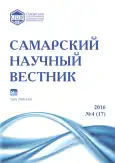Organism chronic intoxication influence on pig intestines parasitocenoses structure changes
- Authors: Ilyina N.A.1, Kasatkina N.M.1, Vilkova E.A.1, Zotov O.G.1
-
Affiliations:
- Ulyanovsk State Pedagogical University named after I.N. Ulyanov
- Issue: Vol 5, No 4 (2016)
- Pages: 14-17
- Section: 03.02.00 – General Biology
- URL: https://journals.rcsi.science/2309-4370/article/view/22122
- DOI: https://doi.org/10.17816/snv20164102
- ID: 22122
Cite item
Full Text
Abstract
This paper deals with the quantitative and qualitative composition change of pig intestinal microflora in the presence of Candida spp . and presents a technique of Candida spp . pure cultures isolation. The authors show the role of normal intestinal microflora in disease origin and development. The paper presents the study that let the authors find a phenomenon of chronic intoxication of various severity in animals. This study was conducted with the help of the diagnostic System, authored by N.A. Ilyina (2006) during summer months on the basis of pig-breeding complexes OOO «Stroiplastmass - Agroprodukt», OOO «Kurortniy» in the clinical laboratory of the city hospital № 1 in Ulyanovsk. The authors studied the quantitative and qualitative intestinal microflora composition change in the presence of pathogenic Candida spp . and showed the correlation of chronic intoxication degree and dysbiotic changes nature of intestines microbiocenosis. The study also showed a high level of contamination of the pigs with intestinal parasites. The increase of the infestation depended on the pig organism chronic intoxication degree and the level of Candida spp . inoculation.
Full Text
##article.viewOnOriginalSite##About the authors
Natalya Anatolyevna Ilyina
Ulyanovsk State Pedagogical University named after I.N. Ulyanov
Author for correspondence.
Email: n-ilina@mail.ru
doctor of biological sciences, professor of Geography and Ecology Department
Russian Federation, 432001, Ulyanovsk, 100-th anniversary of the birth of V.I. Lenin square, 4Nataliya Mikhailovna Kasatkina
Ulyanovsk State Pedagogical University named after I.N. Ulyanov
Email: kasatnm@mail.ru
candidate of biological sciences, associate professor of Geography and Ecology Department
432001, Ulyanovsk, 100-th anniversary of the birth of V.I. Lenin square, 4Evgeniya Alexandrovna Vilkova
Ulyanovsk State Pedagogical University named after I.N. Ulyanov
Email: karpeeva30@mail.ru
candidate of biological sciences, associate professor of Geography and Ecology Department
Russian Federation, 432001, Ulyanovsk, 100-th anniversary of the birth of V.I. Lenin square, 4Oleg Gennadyevich Zotov
Ulyanovsk State Pedagogical University named after I.N. Ulyanov
Email: zotoff23@mail.ru
assistant of Geography and Ecology Department
Russian Federation, 432001, Ulyanovsk, 100-th anniversary of the birth of V.I. Lenin square, 4References
- Бурова С.А., Воинова Г.В. Клинические разновидности и лечение кандидоза // Вестник дерматологии. 1997. № 4. С. 24-28.
- Мюллер Э., Лёффлер В. Микология. М.: Мир, 1995. 343 с.
- Петровская В.Г., Марко О.П. Микрофлора человека в норме и патологии. М.: Медицина, 1976. 221 с.
- Смоленцева Е.В. Современное состояние и перспективы развития отрасли свиноводства в Российской Федерации // Проблемы современной науки и образования. 2014. № 11(29). С. 56-59.
- Шендеров Б.А. Медицинская микробная экология и функциональное питание: в 3 т. Т. 1. Микрофлора человека и животных и ее функции. М.: ГРАНТь, 1998. 288 с.
- Емельяненко П.А. Ветеринарная микробиология. М.: Колос, 1982. 304 с.
- Сергеев А.Ю., Сергеев Ю.В. Грибковые инфекции. М., 2003. 440 с.
- Хардинг Д.В. Новые подходы к контролю заболевания поросят // Ветеринария сельскохозяйственных животных. 2010. № 10. С. 47-48.
- Экология микроорганизмов: Учеб. для студ. вузов / под ред. А.И. Нетрусова. М.: Академия, 2004. 272 с.
- Шевяков М.А.Кандидоз органов пищеварения: клиника, диагностика, лечение: дис. … д-ра мед. наук. СПб, 2000. С. 77-79.
- Тетерев И.И., Тимошенко Т.А. Основные принципы лабораторной диагностики бактериозов, микоплазмозов, риккетсиозов, хламидиозов, микозов и микотоксикозов животных: учебное пособие. Киров: Вятская ГСХА. 2006. С. 10-37.
- Акбаева М.Ш. Паразитология и инвазионные болезни животных. М. Колос, 2002. 743 с.
- Болоцкий И.А., Васильев А.К., Семенцов В.И., Пруцаков С.В. Инфекционные болезни свиней: учебное пособие. Ростов н/Д.: Феникс, 2007. 250 с.
- Карпеева Е.А., Ефремова И.Д., Шабанов Д.В., Ильина Н.А. Вирулентность изолятов Balantidium coli // Фундаментальные исследования. 2010. № 2. С. 45-47.
- Колмацкий Г.В., Нестеренко М.А. Стратегия управления инновационным развитием свиноводства // Проблемы современной экономики. 2010. № 4(36). С. 361-364.
- Колычев Н.Н., Госманов Р.Г. Ветеринарная микробиология и иммунология. М.: Колос, 2003. 432 с.
- Куриленко А.Н., Крупальник В.Л., Пименов Н.В. Бактериальные и вирусные болезни молодняка сельскохозяйственных животных. М.: Колос, 2005. 466 с.
- Покровский В.И., Поздеев О.К. Медицинская микробиология. Москва, 1999. 1184 с.
- Сергиев В.П., Лебедева М.Н. Распространение паразитарных болезней и их профилактика в России // Мед. паразитол. 1997. № 3. С. 5-9.
- Сомов Г.П., Литвин В.Ю. Сапрофитизм и паразитизм патогенных бактерий: экологические аспекты. Новосибирск, 1988. С. 11-14.








